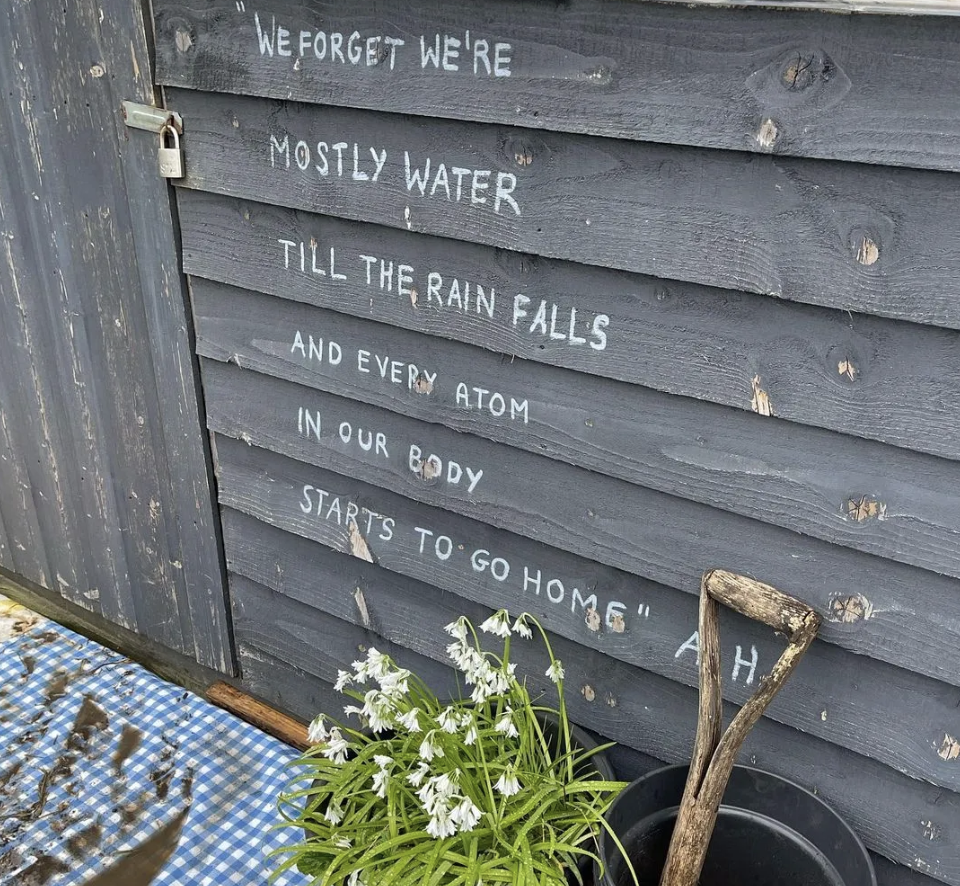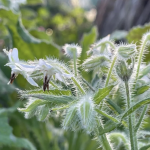On facing silence
Good morning, and Happy New Year 2023!
It’s winter. We are taking this time to rest. Our allotment is resting, too. Very few plants are still busy, so my options to admire growing Nature are limited. As I focus more on heavier jobs (improving soil, tidying up messy branches, maintaining the shed and greenhouse), I can still admire the borage. Our white and blue borage plants are everywhere, and I cannot get enough of their fluffy flowers. In Nature, spikes usually signal danger, yet those little bushy plants feel more like a fluffy carpet. They look stunning and work as a marvellous addition to any meal. I love freezing them in ice cubes for summer mocktails. Borage is a plant to grow if you want a whole sensory experience.
Plant-watching is my favourite activity on the allotment plot because it calms my mind and helps me slow down and enter the pleasant state of lighter flow. We are, of course, talking about mindfulness here – which in some circles is still considered a hip trend, but in psychology, it is now finally well-established as a tool to support healing.
Watching various blooms, the structure of leaves and the reflection of sunlight on tree branches help me cultivate my core character strength (from Seligman’s set of 24): the appreciation of beauty and excellence. Barbara Fredrickson also identifies another strength that I practice here: awe. Awe is incredibly helpful to nurture as it can be a powerful tool to open up our senses during stressful times. When we experience anxiety, stress, fear, loss and other heavy emotions, our awareness has to narrow down to specific factors to address them and to keep us safe. We struggle to see other perspectives; we can become snappy and short-tempered, shut down, or we may struggle to control our actions and sensations. So we need grounding, and grounding in Nature can be as soft as noticing the beauty around us. We land in Nature so fast because every cell in our body knows we belong here.

Watching Nature grow helps me nurture my inner self, which – when busy – I can easily forget. We spend a lot of time in our day distracting ourselves from sitting in silence with our inner thoughts. Mindfulness helps with that. However, in times of multiple jobs, consumerist noise and a screen-based economy, we may find less time for BEING HUMAN. We need to make time for just sitting, doing nothing, listening to the silence, and facing the silence inside of us. Sometimes, when I speak those words out loud, people around me feel uneasy because we do not even like to think or talk about it.
We hear, read and frequently express so many negative opinions about the addictive nature of mobile phones and social media. However, we hardly ever discuss the why, the how, and what the alternative would be.
If we think about this critically, we can quickly identify a lot of activities on the phone that are meaningful: staying safe in unsafe spaces, contact with family and friends, organising, shopping for food, online learning, finding inspiration, expressing creativity, and play (yes, play used to be a respected and very important part of our lives, only in the digital age it became stigmatised so much), as well as reading the news (also incredibly stigmatised and avoided because many people don’t bother curating their sources, instead blame the noise they themselves sign up for). Let’s face it: we judge the act of holding a smartphone in our hands, which is a vast simplification, right?
We also avoid talking about alternatives. What are we not doing while staying on the phone? What is the phone’s function? In mental health, we call something a function of something else if it becomes a normal reaction to abnormal reality. For example, self-harm can be a function of a severe lack of control over a person’s vital life circumstances (note that even shopping or excessive exercising can be a form of self-harm). So let’s think about this. If excessive or maybe even normal levels of smartphone use during our day were a function (healthy/meaningful result of something to help us cope), what would it be?
We will all have unique answers, so here is mine: when I started asking myself this question a few years ago, I realised that for me, it was the fear of facing myself and my inner void. Notice: not the actual void or inner worlds but the mere FEAR of it. I do not feel empty at all, and I do like myself, so this sudden fear of what would happen if I just sat with myself was artificial. I traced it back to our neoliberal culture, consumerism and advertising, which forces us to think that we are never enough. (Again, when we’re clumsy, we blame social media for this, but we actually mean mainstream media here). I was fortunate enough to study bereavement counselling with Oxford Cruse (an office known nationally for fantastic training on bereavement). I spent hours, days, weeks, and months exploring my relationship with death and the silence that comes with it. I was made to sit in silence with myself and other people, explore the feeling and discuss it. We explored suicide, too, and all the silences that come with that act.
And so I came away with clarity that sometimes I need to distract myself on the phone from my subconscious fear of silence, maybe even mortality. (Please remember: we overuse the word “distract” too – mostly, many of us use phones for real productivity, connection or play). It feels like I have walked a path most people don’t take or certainly do not walk as far as we did in our training, and I find it incredibly useful when I support people with excessive use of technology for the avoidance of something. Sometimes, avoidance is very healthy, and we first need to determine that. If we grieve a broken friendship or the “loss” of a child that just went to uni, grieving takes a lot of energy, and so we have to rest. Playing a few online games with our friendly tribe or watching a new series served to our interest by an algorithmic streaming channel is a healthy way of coping. As long as we feel it is helpful to our recovery towards a more balanced life. As long as we check in with ourselves now and again to see how we are and how those digital activities serve us.
When I feel that I may lose myself in the digital distractions and get that sense of unhealthy, pulling void, I step away and practice sitting offline in silence. Marina Abramovic is my inspiration for this. Her artistic collaboration with WeTransfer is still available online, where she shares her ways of practising the perseverance of sitting with herself. You can learn it all here. I think practising sitting in silence with our inner selves can be difficult at first, so please take care and talk to someone close to anchor yourself in collective support. Mindfulness practices like the Headspace app also help. However, with time and practice, you may notice a gradual opening to the idea of inner peace, inner growth, and maybe even adventure.
When we meet ourselves in silence, we can also start shaping our relationships. It’s something Abramovic demonstrated in her “A Minute of Silence” project, during which she sat for a minute in silence facing members of the public. It’s an exercise we do during counselling studies, and it is something we all experience in a safe, loving, kind relationship. So I think we deserve to have a loving, kind relationship with ourselves too. And here is the balanced view: if we have a good, balanced relationship with ourselves, we will use digital technologies to support it, not against it. It is actually quite simple when we think critically about it.
(Reflection)
Today, I would like to offer you my personal morning “meditation” and check in with myself. You can do it anytime, but you do need a moment of uninterrupted time, so if it’s not possible at home, find a place elsewhere, go for a walk or sit in a coffee shop (if you can switch off the public noise). Make yourself (or order) a warm, non-alcoholic drink and drink it mindfully (paying attention to its properties, activating all your senses, and doing it a little bit slower than usual). As you drink it, reflect on the following questions:
How am I today? How am I really? How is my body? How is my mind? How is my spirituality? How am I in my relationships?
How is this silence for me right here, right now? How is this silence for me?
What is in this silence? Maybe nothing? Maybe something?
What do I need to shift slightly to sit more comfortably in this silence? Do I need to focus my attention on my physical sensations to stop my thoughts from racing? Do I need to hug myself to stop the anxiety that comes with silence? What do I need right now to feel well?
How easy is it to transition into this meeting with myself and to transition back to the connection with the world around me? What can help this process? Do I need a blanket, warm light, solitude or maybe someone in the room who keeps me safe?
Am I thinking about my phone as I sit here? Can I forget about it?
If any, what could be the role of my smartphone in facilitating this state? Can I listen to music while I sit here, for example, without looking at the phone?
(These days, I am coming out of a super busy and stressful year, so I often distract myself with my phone to find rest, amongst other things like dog walking, colouring or reading books. I am now using my wintering time to shift back to less time on the phone, but I do so gradually. I am allowing more and more time to sit in silence and reflect on the year – here’s my 2022 write-up with learnings – and how I have changed. But it’s hard work, so I also accept the need to play Angry Birds and relax. And that’s okay, too. Have a good first day of the new year and a fantastic 2023 ahead!)
This post was originally posted on Substack in our Syl’s Liberation Psychologies Newsletter.

